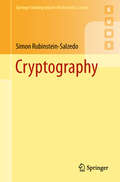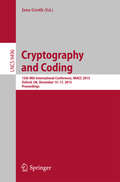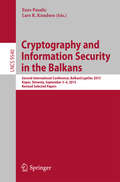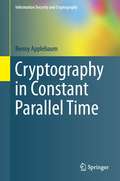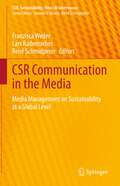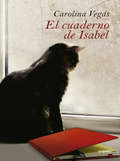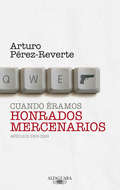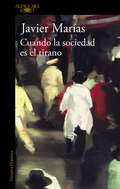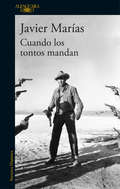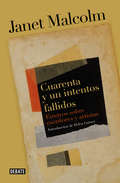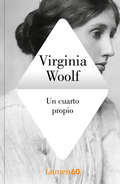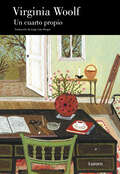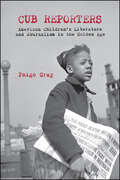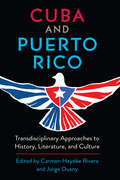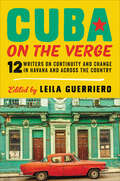- Table View
- List View
Cryptography (Springer Undergraduate Mathematics Ser.)
by Simon Rubinstein-SalzedoThis text introduces cryptography, from its earliest roots to cryptosystems used today for secure online communication.Beginning with classical ciphers and their cryptanalysis, this book proceeds to focus on modern public key cryptosystems such as Diffie-Hellman, ElGamal, RSA, and elliptic curve cryptography with an analysis of vulnerabilities of these systems and underlying mathematical issues such as factorization algorithms. Specialized topics such as zero knowledge proofs, cryptographic voting, coding theory, and new research are covered in the final section of this book.Aimed at undergraduate students, this book contains a large selection of problems, ranging from straightforward to difficult, and can be used as a textbook for classes as well as self-study. Requiring only a solid grounding in basic mathematics, this book will also appeal to advanced high school students and amateur mathematicians interested in this fascinating and topical subject.
Cryptography and Coding: 15th IMA International Conference, IMACC 2015, Oxford, UK, December 15-17, 2015. Proceedings (Lecture Notes in Computer Science #9496)
by Jens GrothThis book constitutes the proceedings of the 15th IMA International Conference on Cryptography and Coding, IMACC 2015, held at Oxford, UK, in December 2015. The 18 papers presented together with 1 invited talk were carefully reviewed and selected from 36 submissions. The scope of the conference was on following topics: authentication, symmetric cryptography, 2-party computation, codes, Boolean functions, information theory, and leakage resilience.
Cryptography and Information Security in the Balkans: Second International Conference, BalkanCryptSec 2015, Koper, Slovenia, September 3-4, 2015, Revised Selected Papers (Lecture Notes in Computer Science #9540)
by Enes Pasalic Lars R. KnudsenThis book contains revised selected papers fromthe Second International Conference on Cryptology and Information Security inthe Balkans, BalkanCryptSec 2015, held in Koper, Slovenia, in September 2015. The 12 papers presented inthis volume were carefully reviewed and selected from 27 submissions. They areorganized in topical sections named: symmetric key cryptography; cryptanalysis;security and protocols; and implementation and verifiable encryption.
Cryptography and Secure Communication
by Richard E. BlahutToday's pervasive computing and communications networks have created an intense need for secure and reliable cryptographic systems. Bringing together a fascinating mixture of topics in engineering, mathematics, computer science, and informatics, this book presents the timeless mathematical theory underpinning cryptosystems both old and new. Major branches of classical and modern cryptography are discussed in detail, from basic block and stream cyphers through to systems based on elliptic and hyperelliptic curves, accompanied by concise summaries of the necessary mathematical background. Practical aspects such as implementation, authentication and protocol-sharing are also covered, as are the possible pitfalls surrounding various cryptographic methods. Written specifically with engineers in mind, and providing a solid grounding in the relevant algorithms, protocols and techniques, this insightful introduction to the foundations of modern cryptography is ideal for graduate students and researchers in engineering and computer science, and practitioners involved in the design of security systems for communications networks.
Cryptography in Constant Parallel Time (Information Security and Cryptography)
by Benny ApplebaumLocally computable (NC0) functions are "simple" functions for which every bit of the output can be computed by reading a small number of bits of their input. The study of locally computable cryptography attempts to construct cryptographic functions that achieve this strong notion of simplicity and simultaneously provide a high level of security. Such constructions are highly parallelizable and they can be realized by Boolean circuits of constant depth. This book establishes, for the first time, the possibility of local implementations for many basic cryptographic primitives such as one-way functions, pseudorandom generators, encryption schemes and digital signatures. It also extends these results to other stronger notions of locality, and addresses a wide variety of fundamental questions about local cryptography. The author's related thesis was honorably mentioned (runner-up) for the ACM Dissertation Award in 2007, and this book includes some expanded sections and proofs, and notes on recent developments. The book assumes only a minimal background in computational complexity and cryptography and is therefore suitable for graduate students or researchers in related areas who are interested in parallel cryptography. It also introduces general techniques and tools which are likely to interest experts in the area.
A Cryptography Primer
by Philip N. KleinCryptography has been employed in war and diplomacy from the time of Julius Caesar. In our Internet age, cryptography's most widespread application may be for commerce, from protecting the security of electronic transfers to guarding communication from industrial espionage. This accessible introduction for undergraduates explains the cryptographic protocols for achieving privacy of communication and the use of digital signatures for certifying the validity, integrity, and origin of a message, document, or program. Rather than offering a how-to on configuring web browsers and e-mail programs, the author provides a guide to the principles and elementary mathematics underlying modern cryptography, giving readers a look under the hood for security techniques and the reasons they are thought to be secure.
Crystallized Memories: Award Winning Telugu Essays
by Cekuri Rama Rao M. V. Chalapathi RaoCrystallized Memories is the translation of Chekuri Rama Rao's Smriti Kinankam.
CSR Communication in the Media: Media Management on Sustainability at a Global Level (CSR, Sustainability, Ethics & Governance)
by Franzisca Weder Lars Rademacher René SchmidpeterCorporate social responsibility (CSR) is an established management focus of today's companies and organizations of different types, scope and size. Communication practices on CSR and sustainability in the media industry, related theoretical concepts, and empirical foundations have not yet been sufficiently explored. This book focuses on a new normative framework of sustainability, bridging the established debate on public value with the current debate on social impact and the social license to operate in the media industry. With a variety of contributions from theory and practice, the book addresses the dual nature of media and media companies, which simultaneously produce economic and cultural goods and thus bear a "double responsibility": on the one hand, for the way they present reality, monitor and criticize economic and political developments, and bring ethical concerns to the public debate. On the other hand, they bear responsibility for their own activities as companies (license to operate). The book is therefore aimed at readers interested in the journalistic perspective and at executives in the media industry.
The CTR Anthology
by Alan FilewodSince its inception in 1974, "Canadian Theatre Review" has been one of the most important publishers of new Canadian plays. With a script in each issue, CTR has introduced new writers and advocated new approaches to Canadian drama. This volume brings together fifteen of the most significant plays published in CTR between 1974 and 1991. Most have been out of print since their appearance in the journal. They include recognized classics that have transformed Canadian theatre, such as "Ten Lost Years" and "This is for You, Anna," and lesser-known plays by such major writers as Robert Lepage and George F. Walker. Taken together these plays not only expand the boundaries of Canadian drama; they also document an important and exciting period in Canadian theatre. They are vivid testaments to the diversity of contemporary theatrical practice in Canada.
El cuaderno de Isabel
by Carolina Vegas MolinaIsabel es una joven periodista que vive sola con su gatoLancelot en un apartamento al borde de un parque; le gustaleer y tomarse un vino cuando llega del trabajo; no tienepareja fija y cuida con celo su profesión, su belleza y, a diferenciade su madre, su independencia. Pero un día descubreque tiene un tumor en el seno, un tumor en estadoavanzado, y ese mundo perfecto que ha querido construir asu medida, se ve sacudido dramáticamente. A partir de esemomento, Isabel tendrá que enfrentar con valor un procesoque implicará un vuelco total en su vida.Esta novela relata de manera muy vívida y directa el miedo,la esperanza y la transformación que trae consigo una enfermedadcomo el cáncer."Nos faltaban muchas de las cosas que por fin están en este cuadernoy en su entrañable Isabel. No sólo nos faltaba la crónicadel dolor contemporáneo en la enfermedad antigua. Nos faltabasobre todo la historia de madres e hijas en la prosa de nuestroidioma, y el vértigo, el tobogán emotivo que se mide con el tiempodel cáncer, pero también con las deshoras de la voluntad de serotra entre los otros. El cuaderno de Isabel es entonces una obranecesaria, esperada y valiente".IGNACIO PADILLA
Cuaderno del escritor, Grado K: Writer's Notebook Grade K (¡Arriba la Lectura!)
by Houghton HarcourtNIMAC-sourced textbook
Cuando éramos honrados mercenarios (2005-2009)
by Arturo Pérez-Reverte¿Qué es lo que hace que hoy, después de dieciséis años escribiendo semana tras semana, sigan impactando de tal manera estos artículos? Los artículos reunidos en este libro se han publicado durante un tiempo que ha pasado de la euforia económica al derrumbe. El siglo XXI se abrió con el entusiasmo de la expansión financiera, el crecimiento de la Bolsa, la fiebre inversora, las rentabilidades rápidas, los créditos fáciles y muchas recalificaciones urbanísticas. Tanta frivolidad derivaría pronto en una de las crisis más profundas de la historia reciente. En este tiempo, Arturo Pérez-Reverte ha seguido publicando artículos semanales, como ha hecho puntualmente desde hace casi veinte años. En ellos está el latido de las incertidumbres que han dominado la primera década del siglo. Algunos han resultado premonitorios. «Estos textos son una mirada disidente, crítica y personal sobre el mundo. En una sociedad acostumbrada al tópico, a la manipulación, a la atonía de lo políticamente correcto, los artículos de Arturo Pérez-Reverte se atreven a observar la vida desde un punto de vista personal. Ese es su reto y su valor.»José Luis Martín Nogales «Escribo con tanta libertad que me sorprende que me dejen.»Arturo Pérez-Reverte
Cuando la sociedad es el tirano
by Javier MaríasCuando la sociedad es el tirano reúne los noventa y seis artículos publicados por Javier Marías en el suplemento dominical El País Semanal entre el 5 de febrero de 2017 y el 27 de enero de 2019. En tiempos en los que asistimos al triunfo de las radicalidades, las medias verdades y los bulos, los artículos de Javier Marías constituyen una especie de crónica política, cultural y social de la actualidad que se ha vuelto imprescindible para infinidad de lectores. Evitando los convencionalismos, el discurso de lo políticamente correcto y los lugares comunes, el autor nos ofrece aquí una muestra de lo que supone pensar libremente, con argumentos construidos de manera sólida y un estilo elegante en el que brilla también su excelente sentido del humor.
Cuando los tontos mandan
by Javier MaríasEste volumen reúne los noventa y cinco artículos publicados por Javier Marías en el suplemento dominical El País Semanal entre el 8 de febrero de 2015 y el 29 de enero de 2017. Noventa y cinco piezas que ofrecen una instantánea de la realidad, del gran articulista de la prensa española actual. <P><P>«¿Se puede hacer algo en un mundo en el que contamos con grabaciones, con sonido e imágenes, con máquinas calculadoras más fiables que nunca, y todo ello se refuta con desfachatez? ¿Estamos adormilados, hipnotizados o simplemente idiotizados para creer más a los distorsionadores que a nuestros ojos y oídos, y aun que a la aritmética?», se pregunta el autor en uno de los textos incluidos en este libro. <P><P> Y concluye su reflexión: «Si es así, rindámonos». Vivimos tiempos en los que no se puede soslayar el triunfo de las radicalidades, de las militancias de todo signo y de los buloscotidianos; la célebre posverdad se impone a lo real y gran parte de los ciudadanos solo lee, oye o ve a los de su cuerda, atrincherados en la comodidad de un pensamiento coincidente. En estas circunstancias, Javier Marías es un outsider necesario. <P><P>Con su estilo elegante, su exquisita educación y su gran sentido del humor, lleva a cabo en sus artículos algo infrecuente: matizar, razonar, dar mandobles a unos y a otros cuando lo considera conveniente, no ejercer banderías ni lo políticamente correcto. En medio del ruido global en el que estamos inmersos, las piezas de opinión recogidas en Cuando los tontos mandan resultan indispensables para formarnos una opinión personal sobre gran variedad de temas y para entender el mundo actual. Y confirman a Javier Marías como una de las voces más representativas y valoradas de la auténtica disidencia.
Cuarenta y un intentos fallidos: Ensayos sobre escritores y artistas
by Janet MalcolmLos mejores ensayos sobre arte y literatura de una maestra del periodismo Uno de los libros del 2013 para el Publisher Weekly y finalista del premio de la crítica de EEUU La obra de Janet Malcolm figura destacada en cualquier canon de la no ficción contemporánea, con piezas tan brillantes como la que da título a esta antología, con sus cuarenta y un intentos fallidos de comenzar un perfil del pintor David Salle, que acaban componiendo un retrato excepcional del artista. Malcolm está entre los autores más estimulantes intelectualmente, capaz de convertir «epifanías de la percepción en estallidos de conocimiento» como escribió David Lehman en The Boston Globe. Esta antología reúne piezas publicadas a lo largo de varias décadas, sobre todo en The New Yorker y The New York Review of Books, que recogen su interés por los artistas y su trabajo, pintores, fotógrafos, escritores y críticos. Explora la obsesión del grupo de Bloomsbury por la creación tanto plástica como literaria; las apasionadas colaboraciones que hay detrás de los desnudos de Edward Weston; y la personalidad del fotógrafo alemán Thomas Struth, que vive «bajo la sombra de su pasado nazi», pero cuyas fotografías muestran «ligereza de espíritu». Se asoma a la ficción de Edith Wharton y a los héroes puros de Salinger. «Una y otra vez», como escribió Ian Frazier, «demuestra que la no ficción, un libro reportaje, un artículo de revista, algo que vemos a diario, puede alcanzar el más alto nivel literario.» La crítica ha dicho... «Cuarenta y un intentos fallidos es una obra notable y a su extraña manera fascinante. Consigue algo muy difícil: explicar algo valioso sobre un tema tan inasible como es el proceso creativo.» Zoe Heller, The New York Review of Books «Una excelente colección de ensayos. Malcolm probablemente sea la escritora más dotada del periodismo americano.» Chicago Tribune «Periodismo inteligente que siempre se nota que ha sido escrito por un ser humano, con un corazón que late, un sentido moral, una curiosidad muy amplia y un punto de vista.» Laura Collins-Hughes, The Boston Globe «Sin duda la obra de un genio.» Adam Kitsch, New York Times
Un cuarto propio (Biblioteca De Traduc Ser. #Vol. 0736)
by Virginia WoolfEl ensayo sobre la condición femenina que se ha convertido en un icono de la literatura y del feminismo. Es notable, pensé, [...] la transformación que una renta fija opera en el carácter de las personas. [...] No necesito odiar a ningún hombre; no me puede hacer mal. No preciso adular a ningún hombre; no tiene absolutamente nada que darme. Imperceptiblemente adopté una nueva actitud hacia la otra mitad del género humano. Era absurdo culpar a una clase o a un sexo en conjunto. Grandes masas de gente nunca son responsables de lo que hacen. [...] Había #empecé a pensar# dominado la primera gran lección, escribir como una mujer; pero como una mujer que ha olvidado que lo es, de modo que sus páginas estaban llenas de esa curiosa calidad sexual que sólo se adquiere cuando el sexo no es inconsciente de sí mismo. «Yo creía haber leído Un cuarto propio. Hay libros tan célebres, tan obvios, tan citados que uno tontamente los da por leídos, aunque los leyera hace muchísimo tiempo y ya no recuerde nada, aunque no sepa seguro si llegó a leerlos o imaginó que los leía, o simplemente presumió distraídamente de haber leído. Yo creía haber leído Un cuarto propio. Y quién no: trata de que una mujer necesita una habitación propia y ciertos ingresos para escribir, etcétera. Lo empecé a media tarde y claro que me sonaba. Al cabo de dos o tres páginas era una sorpresa incesante. Qué escritora más inmensa: más serena y rotunda en su enfado de mujer harta de limitaciones impuestas y de condescendencias masculinas, qué radical su defensa de la literatura, del oficio de escribir, de la alegría y la conmoción de leer.» Antonio Muñoz Molina La crítica ha dicho sobre la autora...«En la obra de Virginia Woolf se dieron unas cualidades heredadas y una voluntad inéditas e irrepetibles en la historia de la cultura inglesa.»T. S. Elliot «Leyéndola, se percibe el funcionamiento de una gran integridad crítica.»Leonard Woolf «Virginia Woolf sentó las bases de la novela del futuro.»Jeanette Winterson «Qué escritora más inmensa, más severa y rotunda en su enfado de mujer harta de limitaciones.»Antonio Muñoz Molina «Una de las inteligencias e imaginaciones más delicadas que ensayaron felices experimentos con la novela inglesa.»Jorge Luis Borges «Virginia Woolf sostuvo la luz de la lengua inglesa contra la oscuridad.»E. M. Forster «No puedo imaginarme un escritor cuya devoción por su arte, esfuerzo y severidad consigo misma [...] siga siendo un ejemplo que sea a la vez una inspiración y un juez.»W.H. Auden
Un cuarto propio (Biblioteca De Traduc Ser. #Vol. 0736)
by Virginia WoolfUn cuarto propio es un breve ensayo de Virginia Woolf sobre la condición femenina que se ha convertido en un icono de la literatura del siglo XX. «No hay marca en la pared para medir la precisa estatura de las mujeres. No hay medidas que determinen las condiciones de una buena madre o el cariño de una hija, la fidelidad de una hermana o la capacidad de una ama de llaves», comenta Virginia Woolf en este ensayo, pero lo que también nos dice es que para escribir una novela una mujer tiene que tener un cuarto propio y comida caliente; en resumen, tener una vida propia e independiente. Lejos de ser un alegato furibundo contra los hombres, Un cuarto propio es un elegante ensayo que ya en 1929 ponía sobre la mesa unos temas que aun hoy son objeto de debate, como la dependencia económica de la mujer con respecto al hombre, el cuidado de una familia y la figura de la mujer como musa inspiradora del artista pero con pocapresencia en la práctica de la creatividad. Este ensayo, publicado ya repetidas veces en España, se presenta ahora de forma nueva, en traducción de Jorge Luis Borges, con prólogo de Kirmen Uribe y espléndidas ilustraciones de la joven dibujante norteamericana Becca Stadtlander. «La vida para todos nosotros, hombres y mujeres, es difícil, ardua: una lucha que no se acaba nunca y nos reclama mucho valor y fuerza. Bien mirado, lo que quizá nos reclame más que nada, siendo como somos criaturas hechas de vaguedades, es confianza en nosotros mismos.»Virginia Woolf
Cub Reporters: American Children's Literature and Journalism in the Golden Age
by Paige Marie GrayCub Reporters considers the intersections between children's literature and journalism in the United States during the period between the Civil War and World War I. American children's literature of this time, including works from such writers as L. Frank Baum, Horatio Alger Jr., and Richard Harding Davis, as well as unique journalistic examples including the children's page of the Chicago Defender, subverts the idea of news. In these works, journalism is not a reporting of fact, but a reporting of artifice, or human-made apparatus—artistic, technological, psychological, cultural, or otherwise. Using a methodology that combines approaches from literary analysis, historicism, cultural studies, media studies, and childhood studies, Paige Gray shows how the cub reporters of children's literature report the truth of artifice and relish it. They signal an embrace of artifice as a means to access individual agency, and in doing so, both child and adult readers are encouraged to deconstruct and create the world anew.
Cuba and Puerto Rico: Transdisciplinary Approaches to History, Literature, and Culture
by Carmen Haydée Rivera Jorge DuanyThe intertwined stories of two archipelagos and their diasporas This volume is the first systematic comparative study of Cuba and Puerto Rico from both a historical and contemporary perspective. In these essays, contributors highlight the interconnectedness of the two archipelagos in social categories such as nation, race, class, and gender to encourage a more nuanced and multifaceted study of the relationships between the islands and their diasporas. Topics range from historical and anthropological perspectives on Cuba and Puerto Rico before and during the Cold War to cultural and sociological studies of diasporic communities in the United States. The volume features analyses of political coalitions, the formation of interisland sororities, and environmental issues. Along with sharing a similar early history, Cuba and Puerto Rico have closely intertwined cultures, including their linguistic, literary, food, musical, and religious practices. Contributors also discuss literature by Cuban and Puerto Rican authors by examining the aesthetics of literary techniques and discourses, the representation of psychological space on the stage, and the impacts of migration. Showing how the trajectories of both archipelagos have been linked together for centuries and how they have diverged recently, Cuba and Puerto Rico offers a transdisciplinary approach to the study of this intricate relationship and the formation of diasporic communities and continuities. Publication of this work made possible by a Sustaining the Humanities through the American Rescue Plan grant from the National Endowment for the Humanities.
Cuba and the Tempest
by Eduardo GonzálezIn a unique analysis of Cuban literature inside and outside the country's borders, Eduardo Gonzalez looks closely at the work of three of the most important contemporary Cuban authors to write in the post-1959 diaspora: Guillermo Cabrera Infante (1929-2005), who left Cuba for good in 1965 and established himself in London; Antonio Benitez-Rojo (1931-2005), who settled in the United States; and Leonardo Padura Fuentes (b. 1955), who still lives and writes in Cuba. Through the positive experiences of exile and wandering that appear in their work, these three writers exhibit what Gonzalez calls "Romantic authorship," a deep connection to the Romantic spirit of irony and complex sublimity crafted in literature by Lord Byron, Thomas De Quincey, and Samuel Taylor Coleridge. In Gonzalez's view, a writer becomes a belated Romantic by dint of exile adopted creatively with comic or tragic irony. Gonzalez weaves into his analysis related cinematic elements of myth, folktale, and the grotesque that appear in the work of filmmakers such as Alfred Hitchcock and Pedro Almodovar. Placing the three Cuban writers in conversation with artists and thinkers from British and American literature, anthropology, philosophy, psychoanalysis, and cinema, Gonzalez ultimately provides a space in which Cuba and its literature, inside and outside its borders, are deprovincialized.
Cuba on the Verge: 12 Writers on Continuity and Change in Havana and Across the Country
by Leila GuerrieroSpanning politics and art, music and baseball, Cuba on the Verge is a timely look at a society’s profound transformation—from inside and outChange looms in Cuba. Just ninety miles from United States shores yet inaccessible to most Americans until recently, Cuba fascinates as much as it confounds. Images of the Buena Vista Social Club, wild nights at the Tropicana, classic cars, and bearded rebels clinching cigars only scrape the surface of Cuba’s complex history and legacy. As the US and Cuba move toward the normalization of diplomatic relations after an epic fifty-six-year standoff, we find ourselves face-to-face with one of the few places in the world that has been off limits to most Americans. We know that Cuba is changing, but from what and into what? And what does this change mean for the Cuban people as well as for the rest of the world? Standing on both sides of the divide, twelve of our most celebrated writers investigate this period of momentous transition in Cuba on the Verge. These essays span the spectrum, from Carlos Manuel Álvarez’s story of being among the last generation of Cubans to be raised under Fidel Castro to Patricia Engel’s look at how Cuba’s capital has changed through her years of riding across it with her taxi driver friend; from The New Yorker’s Jon Lee Anderson (who traveled with President Obama on the first trip to Cuba by an American president since the twenties) on being a foreigner in Cuba during the Special Period to Francisco Goldman on the Tropicana, then and now, to Leonardo Padura on the religion that is Cuban baseball. Cuba on the Verge is the definitive account of—and a unique glimpse at—a moment of upheaval and reinvention whose effects promise to reverberate across years and nations.
